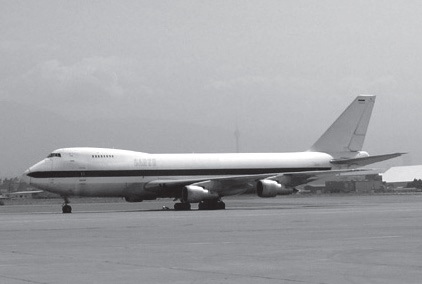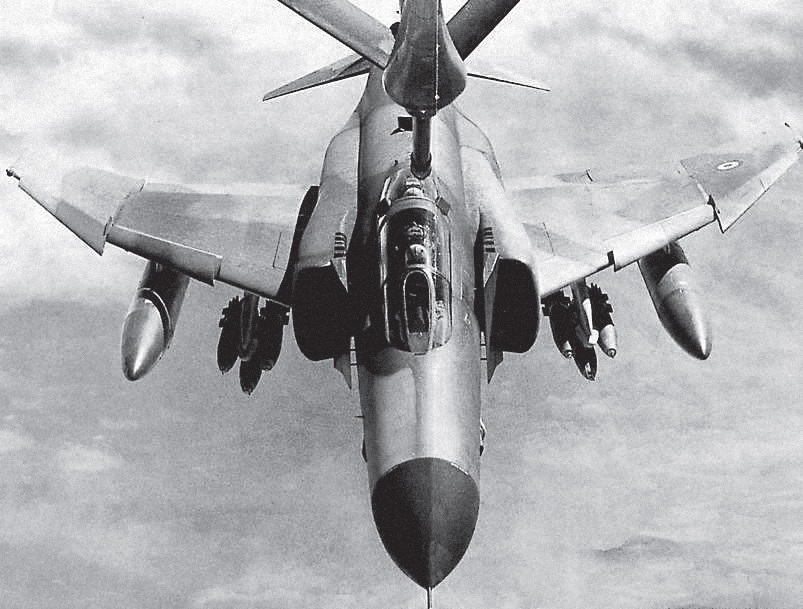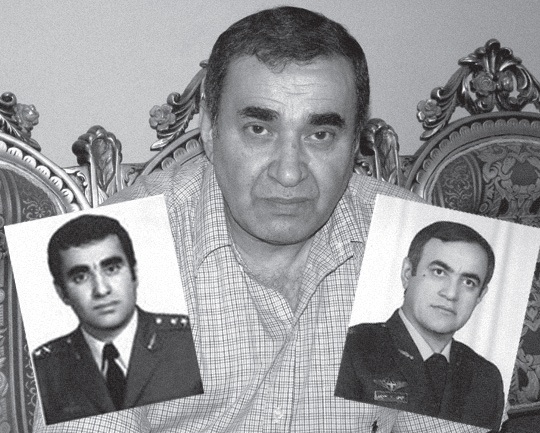Air Raid to Al-Waleed (26)
The Story of Demolishing Fighters and the Equipment in Al-Waleed Triple Military Bases Known as H-32016-07-03
Air Raid to Al-Waleed (H-3)
The Story of Demolishing Fighters and the Equipment in Al-Waleed Triple Military Bases Known as H-3
By: Brigadier General Ahmad Mehrnia
Tehran, Sooreh Mehr Publications Company
2010 (Persian Version)
Translated by: Zahra Hosseinian
Phantoms beyond the western borders of Iraq
Phantoms were approaching the second refueling area. An unusual anxiety as well as fright had embraced pilots. They either asked themselves or their partner: are tankers ready across the Iraq border? Won’t something come up? Given the length of rout and the error of navigation device, will we find properly the considered point with no radio contact with tanker? What would happen if for any reason the Damascus airport don’t allow them fly or delay? Is refueling done safely while the internal fuel tank is almost half empty too? What is our duty if something happens? Can we really get out of Iraq with the money that we have, if we aren’t captured? What will happen if the Syrian radars become aware of the presence of us and send their fighters to us? All our efforts and plans disrupt! Some sometimes think of his wife and children. Will I see my unborn child? Have they now known where we are? What they feel? If I don’t return and other ifs.... Each of them grapples with such questions in a way. But this was not their first flight. This was not the first time that they take a risk in battle with enemy. Again whispering prayers, give comfort and confidence to the team. The Throne Verse is humming again. Also “And We have put a barrier before them and a barrier behind them, then we have blind-folded them, so they do not see.”[1] And “If ye help Allah, He will help you and will make your foothold firm.” And the God remembrance gives certain serenity to these self-sacrificing fighters.

Boeing 747 with the facility of delivering fuel
Pilots of two Boeings 747, which are in the Damascus airport according to the predetermined plan, sign their flight plan and are permitted to fly just in time. The spirit of these pilots of giant tankers is not better than the bombers’. At the height of a thousand feet, in the edge of enemy border and in a third country, they must give fuel to eight F-4 aircrafts twice in a tactical flight, which has been done perhaps only in the form of a few aerial parade. They are also among the God-fearing men of same homeland. Trusting in God, they also entrust everything to Him and do the best thing they can to make the operation is successfully completed.[2] In addition, Ferydoun Izadseta, of operations designers in one of these tankers, closely monitors the implementation of the mission and encourages all participants in this rare operation.
In borders of Iraq, Turkey and Syria, where there is no heights, flight leader turn left for implementing alternative plan or ‘Plan B’. Following him, all pilots turn left. Approaching to the position, they see the tanker is shining under sunlight, so they float on air. With a particular expertise on that low altitude, pilots one after another would lead aircrafts under tanker and refuel with success.

With six 500-pound bombs which have delay wings and two extra fuel tanks, Phantom is refueling.
The important issue in the Plan B was that the leader of tankers must be careful about their position in the South of city ‘al-Hasakah’ and the East of city "Deir ez-Zor", so that not close to them lest the people and the security forces make a situation by seeing aircrafts that jeopardize ourselves in addition to make impression on political relations.
Retired Colonel Hossein Haj Vali Mirza, who accompanied the commander of Boeing 747, Major Pilot Jesus Hosseini, was responsible for delivering fuel to Phantoms and still works in one of airlines as a commander of aircraft, said about the operations:

Colonel Hossein Haj Vali Mirza (2009) and his photo when he had been Lieutenant; Right: Second Brigadier General Jesus Hosseini
"Mentioned mission was conveyed to us. Early morning of April 3rd 1981, two and a half hours before sunrise, I and my colleague Major Jesus Hosseini headed to Damascus airport to ensure the mentioned system functions right, after performing a refueling operation. In this flight, Colonel Pilot Izadseta of Staff Pilots, flight engineer Hossein Ekmali, boomers, and crew chief accompanied us. There is a hotel near the airport, its one floor was reserved for our pilots and every time we went to Syria, stayed there. As usual, we went immediately to the hotel and Izadseta explained in detail how to accomplish our mission and its importance for us and Captain Kamran AmirEtemadi, who had landed in Damascus a day before with his second pilot, Captain Mohammed Eskandarioun. The most important thing that we didn’t expect was implementing the mission along the eastern border Syria instead of inside Iraq.
We had a team of expert mechanics of F-4 aircrafts with predicted equipment and facilities in our aircraft, so that if an unexpected event occurred and we needed mechanic, everything is available. It should be noted that the team accompanied us in the form of mechanic crew for fixing the sham technical fault of Boing747, which was occurred yesterday due to the plan, and we had forced ostensibly to bring some pieces. All coordination was done and tomorrow morning I and Jesus Hosseini, along with Izadseta in the cabin of the other tanker, asked control tower permission to taking off, and following each other taxied on the runway. After taking off from Damascus airport, we climbed and flew on international routes to the Tanf point in southern Syria near the Jordan-Iraq border. From this point we should shift to the north and went to Turkey. According to the brief, from here we started to descent our altitude during left turn and reached to the less than a thousand feet above the earth surface. First, staff of Syria flight control who had no sign or sound of us, and later Turkey’s staff who was worried about our excessive delays, constantly called us. We would hear their voices. But Phantoms had arrived and we were refueling, so didn’t answer to their request. It was the second time that I was flying for the mission at this point. To be honest, I couldn’t believe to see eight insider fighters there, but it was an undeniable fact. I was proud of attending in such an important operation on those dangerous conditions, at a non-standard height, and inside a third country. From North East of Syria, where bombers joined us, we delivered fuel to them again at the Tanf point. From there, they left us and went to bomb targets; and during a short time that sometimes even can’t be understandable, and for me took more than an hour, I would wonder what will happen to these warriors. We all prayed that no tragic incident occurred. We were at the end of circulating at the predetermined point, when first Phantom arrived and pleased us. Phantoms again attached us to take fuel; of course, one of them was in trouble and Izadseta was busy radio talk with its pilot. At the same route until near the North East of Syria, we delivered fuel to seven aircrafts at low altitude, and then said goodbye, and entered into international corridor. Due to the emergency state of F-4, another tanker had been damaged, so with the aim of landing quickly in safe and secure, Colonel Izadseta ordered them to return to the Syria capital; but I heard the phantom landed in another location other than Damascus."
To be continued...
[1]. Yasin Sura, verse 9
[2]. It should be noted that transport aircrafts of Air Force did extraordinary things when war began and there was a need for moving troops, equipment and evacuating the wounded; and sometimes even up to twice of capacity they transported forces to the operational areas from far and near cities in war conditions, at low altitude and the lack of adequate facilities in the evening. Transporting about 1,200 troops by Boeing 747 and 400 troops by Boeing 707 to a base like Omīdīyeh at night, with kerosene lamps beside the runway, repeated frequently. These aircrafts need special advanced equipment for landing. Another responsibility was assumed by brave pilots of Transportation was carrying the wounded, ammunition, equipment and also delivering fuel to fighter /bombers. As the backbone of Air Force tactical transport, C-130 aircraft was used for several jobs at war that needs to be addressed in another book as relevant events.
Number of Visits: 5174
http://oral-history.ir/?page=post&id=6432
